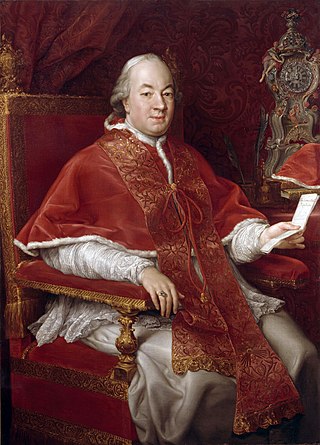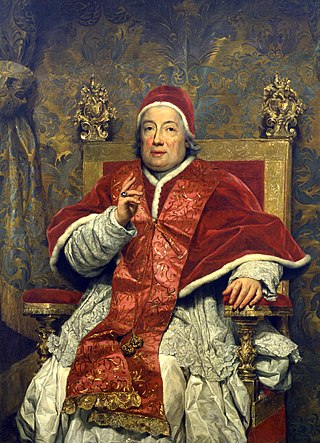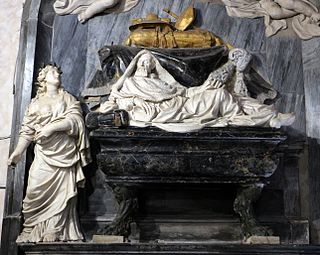This article has multiple issues. Please help improve it or discuss these issues on the talk page . (Learn how and when to remove these template messages)
|

Tommaso Ruffo (1663-1753) was an Italian archbishop of Ferrara and Cardinal.
This article has multiple issues. Please help improve it or discuss these issues on the talk page . (Learn how and when to remove these template messages)
|

Tommaso Ruffo (1663-1753) was an Italian archbishop of Ferrara and Cardinal.
He was born in Naples, son of Carlo Ruffo, 3rd Duke of Bagnara. [1] He was educated at La Sapienza University, becoming a doctor of canon and civil law. He was a papal diplomat, elected titular archbishop of Nicaea in 1698. On 13 Apr 1698, he was consecrated bishop by Fabrizio Spada, Cardinal-Priest of San Crisogono, with Michelangelo dei Conti, Titular Archbishop of Tarsus, and Francesco Acquaviva d'Aragona, Titular Archbishop of Larissa in Thessalia, serving as co-consecrators. [1] [2]
He was created cardinal-priest in 1706, despite having a cousin Giacomo Boncompagni in the College of Cardinals, with the title of S. Lorenzo in Panisperna. Having served as a papal legate, he became archbishop of Ferrara in 1717. He took part in the papal conclave, 1721 and the papal conclave, 1724. He became bishop of Palestrina in 1726 and participated in the papal conclave, 1730. He was bishop of Porto e Santa Rufina 1738. and participated in the papal conclave, 1740. He became Dean of the College of Cardinals and bishop of Ostia e Velletri in 1740, and died in Rome on February 16, 1753. At the time of his death, he was the oldest living cardinal.
| Episcopal succession of Tommaso Ruffo |
|---|
While bishop, he was the principal consecrator of: [2]
and the principal co-consecrator of: [2]
|

Pope Pius VI was head of the Catholic Church and ruler of the Papal States from 15 February 1775 to his death in August 1799.

The papal conclave held from 31 July to 4 August 1903 saw the election of Cardinal Giuseppe Melchiorre Sarto to become pope in succession to Leo XIII, who had died on 20 July after a 25-year-long pontificate. Some 62 cardinals participated in the balloting. Emperor Franz Joseph of Austria asserted the right claimed by certain Catholic rulers to veto a candidate for the papacy, blocking the election of the leading candidate, Cardinal Secretary of State Mariano Rampolla. Sarto was elected on the seventh ballot and took the name Pius X.

In the papal conclave held from 14 to 16 June 1846, Giovanni Maria Mastai Ferretti, Bishop of Imola, was elected on the fourth ballot to succeed the recently deceased Gregory XVI as pope. He took the name Pius IX. Of the 62 members of the College of Cardinals, 52 assembled in the Quirinal Palace, one of the papal palaces in Rome and the seat of two earlier 19th century conclaves. The conclave was the last to elect a ruler of the Papal States, the extensive lands around Rome and Northern Italy which the Catholic Church governed until 1870.

The 1758 papal conclave, convoked after the death of Pope Benedict XIV, elected Cardinal Carlo Rezzonico of Venice, who took the name Clement XIII.

Rainiero d'Elci was an Italian Cardinal.

The 1774–75 papal conclave, was convoked after the death of Pope Clement XIV and ended with the election of Cardinal Giovanni Angelo Braschi, who took the name of Pius VI.
Pier Luigi Carafa, Junior was an Italian cardinal from the famous Neapolitan family of Italian nobles, clergy, and men of arts. He served the papacy as Camerlengo of the Sacred College of Cardinals and as Dean of same College. He is currently buried at Sant'Andrea delle Fratte in Rome.
Bernardino Giraud was a Cardinal of the Catholic Church. He served as Apostolic Nuncio to France from 1767 to 1773, and as Archbishop of Ferrara from 1773 until his resignation in 1777. He was elevated to Cardinal in pectore on 17 June 1771, and installed as Cardinal-Priest of SS. Trinità al Monte Pincio in 1773. He participated in the Papal conclave, 1774–1775.

Giulio Cesare Sacchetti was an Italian Catholic Cardinal and was twice included in the French Court's list of acceptable candidates for the Papacy, in 1644 and 1655.

Francesco Cennini de' Salamandri was an Italian Catholic Cardinal.

Francesco Angelo Rappaccioli was an Italian Catholic Cardinal.

Paluzzo Paluzzi Altieri degli Albertoni was an Italian Catholic Cardinal and Cardinal-Nephew to Pope Clement X.

The 1740 papal conclave, convoked after the death of Pope Clement XII on 6 February 1740, was one of the longest conclaves since the 13th century.

Bandino Panciatici was a Roman Catholic cardinal from 1690 to 1718.

Benedetto II Erba Odescalchi (1679–1740) was an Italian Cardinal and Archbishop of Milan from 1712 to 1736.

Carlo III Gaetano Stampa (1667–1742) was an Italian cardinal and Archbishop of Milan from 1737 to 1742.

Marco Antonio Colonna (1523–1597) was an Italian Roman Catholic bishop and cardinal.

Francesco Sforza (1562–1624) was an Italian cardinal and bishop. He was very influential in a number of conclaves.
Francesco Sacrati was a Roman Catholic prelate who served as Archbishop of Cesena (1622–1623), Cardinal-Priest of San Matteo in Merulana (1621–1623), and Titular Archbishop of Damascus (1612–1622).

Pier Matteo Petrucci, C.O. (1636–1701) was a Roman Catholic cardinal.